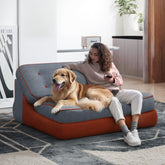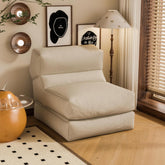Foam Sofa vs. Traditional Sofa: Which Is Right for You?
Why This Choice Matters?
Choosing the right sofa is more than just picking a piece of furniture—it’s about investing in your comfort, lifestyle, and the overall feel of your home. Whether you're furnishing a brand-new space or replacing an old, worn-out couch, the sofa you choose can significantly influence how you relax, entertain guests, and express your personal style. From binge-watching your favorite shows to hosting friends or enjoying quiet evenings with a book, the sofa plays a central role in everyday life.

In recent years, foam sofas have emerged as a modern, versatile alternative to traditional sofas. Known for their lightweight construction, modular design, and budget-friendly pricing, foam sofas appeal to a wide range of consumers—especially those looking for comfort and convenience without compromising on aesthetics. Unlike bulky, heavy traditional sofas that often require professional delivery and installation, foam sofas are easy to assemble, move, and maintain. They’ve gained popularity particularly among urban dwellers, young professionals, and families seeking a balance between function and style.
At the forefront of this shift is Daneey—a brand dedicated to redefining the way we think about home comfort. Specializing in high-quality foam sofas that range from $150 to $500, Daneey offers an affordable way to upgrade your living space without sacrificing quality or visual appeal. Each sofa is crafted with dense, supportive foam that contours to your body, ensuring both durability and long-lasting comfort. With sleek, modern designs and easy shipping options, Daneey makes it simple to furnish any space, from studio apartments to cozy family rooms.
As consumers become more informed and selective about how they spend their money, the choice between a foam sofa and a traditional sofa becomes increasingly important. In this guide, we’ll break down the key differences, benefits, and drawbacks of both options—so you can make the best decision for your home and lifestyle.
Quick Comparison Table
|
Feature |
Foam Sofa (e.g., Daneey) |
Traditional Sofa |
|
Material |
High-density foam |
Springs, wood frame, and fabric |
|
Price Range |
$150 – $500 |
$500 – $1500+ |
|
Weight & Portability |
Lightweight, easy to move |
Heavier, often fixed |
|
Setup & Maintenance |
Tool-free setup, easy to clean |
May require assembly, harder to clean |
|
Comfort |
Adaptive and soft |
Structured, may feel firmer |
|
Style & Customization |
Minimalist, modular designs |
Classic, bulkier styles |
|
Durability |
5–10 years (foam dependent) |
7–15 years (material dependent) |

In-Depth Comparison
A. Materials, Comfort & Durability
When it comes to comfort and longevity, the core materials of a sofa make all the difference. Foam sofas are typically constructed using high-density polyurethane foam. This foam is engineered for both support and softness, and its density rating determines how it performs over time. High-density foam (typically 1.8 lbs/ft³ and above) offers better shape retention, resistance to sagging, and a firmer, more supportive seat. Brands like Daneey focus on using quality foam with excellent rebound rate—meaning the cushion quickly returns to its original shape after sitting, enhancing both comfort and durability.
In contrast, traditional sofas often rely on a combination of wood frames, metal springs, and fiberfill or low-density foam for cushioning. While spring-based support systems can create a structured and bouncy sitting experience, they are also prone to uneven wear. Springs may lose tension over time or break entirely, causing dips in seating. Additionally, lower-quality fill materials can compress quickly, leading to discomfort and costly repairs or replacements.
Another critical consideration is breathability. Foam sofas, especially those designed with open-cell structures or layered with breathable fabrics, allow for better air circulation and temperature regulation. Traditional sofas, depending on their upholstery and fill, may retain heat or become stuffy after extended use.

In terms of aging, high-quality foam gradually softens but generally maintains its shape if properly cared for. Traditional sofas, especially those with fabric that fades or frames that creak, may show visible signs of aging sooner—particularly in households with pets or children.
B. Usage Scenarios
Your living environment and daily habits play a major role in deciding which type of sofa fits best. Foam sofas are ideal for modern living, especially in apartments, dorm rooms, small homes, or multi-functional spaces. They are lightweight, easy to assemble without tools, and can often be moved by a single person. This makes them perfect for renters, students, or anyone who moves frequently. Some foam sofas even offer modular components, allowing you to customize or expand your seating over time.
Traditional sofas, on the other hand, are better suited for permanent setups—such as a dedicated living room in a family home. They tend to be heavier, less portable, and often require professional delivery or installation. Their bulkier design can add a sense of luxury or tradition, but may be impractical for smaller spaces or those who enjoy frequently rearranging furniture.

If you're furnishing a minimalist or contemporary environment, foam sofas offer flexibility without sacrificing style. For a more formal or classic aesthetic, traditional sofas remain a strong choice.
C. Target Audience Fit
Understanding who each sofa type is best for helps simplify the decision-making process.
-
Foam Sofas are best suited for:
-
Millennials and Gen Z buyers looking for affordable, stylish home solutions.
-
Renters or frequent movers who value ease of transport and setup.
-
First-time homeowners on a budget, furnishing their space from scratch.
-
Families with children who need furniture that’s soft, safe, and easy to clean.
-
People living in compact spaces, who benefit from modular or space-saving furniture.
-

-
Traditional Sofas are ideal for:
-
Homeowners seeking a long-term investment in quality furniture.
-
Fans of classic or traditional design, who appreciate structure and heritage styles.
-
Households with large living areas, where bulkier furniture can comfortably fit.
-
Individuals prioritizing high-end materials, like leather or hardwood framing.
-
Those who host frequently, and prefer formal seating arrangements.
-
By identifying your living situation, budget, and lifestyle needs, it becomes much easier to choose between the adaptable foam sofa and the enduring traditional sofa.

Which One Should You Choose?
At the end of the day, the best sofa for you depends on your lifestyle, preferences, and future plans. Both foam sofas and traditional sofas have their strengths, but they cater to different needs and priorities.
If you’re someone who values modern design, ease of mobility, and affordable comfort, a foam sofa is likely the better choice. It’s perfect for those living in smaller spaces, moving frequently, or furnishing a home on a budget. Brands like Daneey specialize in high-quality foam sofas that are not only budget-friendly but also stylish and supportive. Their modular, lightweight design makes setup and rearrangement effortless, without sacrificing durability or aesthetics.
On the other hand, if you’re looking for a long-term investment in legacy furniture, with a preference for classic design, formal structure, and potentially more robust materials like leather or hardwood frames, a traditional sofa might suit you better. It’s a strong match for established homeowners, large households, or anyone furnishing a dedicated living room for years to come.
Ultimately, it’s not about which type of sofa is “better,” but which one is right for you. Take time to evaluate your space, your budget, and how you use your living area daily. The good news? With brands like Daneey making premium foam sofas more accessible than ever, comfort and style don’t have to come at a high cost.

Choosing the right sofa isn’t just a matter of taste—it’s a reflection of your lifestyle, living space, and how you define comfort. Whether you lean toward the flexibility and modern appeal of a foam sofa or the traditional charm of a classic couch, the key is to align your furniture with your real needs.
At Daneey, we believe that everyone deserves a stylish, comfortable sofa without breaking the bank. Our foam sofas are thoughtfully designed to deliver lasting support, easy portability, and minimalist beauty—all at an affordable price point.
Ready to upgrade your space with comfort and convenience?Explore our full collection today at Daneey.comand find the perfect sofa to match your lifestyle.












